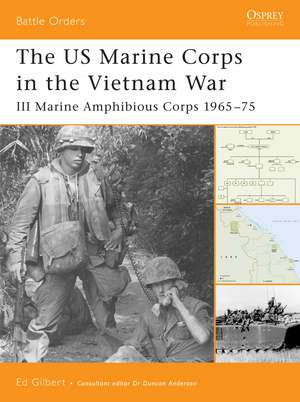The US Marine Corps in the Vietnam War: III Marine Amphibious Force 1965-75: Battle Orders, cartea 19
Autor Ed Gilberten Limba Engleză Paperback – 31 mai 2006
Din seria Battle Orders
- 30%
 Preț: 80.90 lei
Preț: 80.90 lei - 30%
 Preț: 80.99 lei
Preț: 80.99 lei -
 Preț: 80.90 lei
Preț: 80.90 lei -
 Preț: 80.73 lei
Preț: 80.73 lei -
 Preț: 80.81 lei
Preț: 80.81 lei -
 Preț: 81.27 lei
Preț: 81.27 lei - 30%
 Preț: 80.90 lei
Preț: 80.90 lei - 29%
 Preț: 81.27 lei
Preț: 81.27 lei - 29%
 Preț: 81.27 lei
Preț: 81.27 lei -
 Preț: 80.29 lei
Preț: 80.29 lei - 30%
 Preț: 80.99 lei
Preț: 80.99 lei - 30%
 Preț: 80.99 lei
Preț: 80.99 lei - 30%
 Preț: 80.99 lei
Preț: 80.99 lei - 29%
 Preț: 81.09 lei
Preț: 81.09 lei -
 Preț: 80.90 lei
Preț: 80.90 lei - 30%
 Preț: 80.99 lei
Preț: 80.99 lei - 30%
 Preț: 80.90 lei
Preț: 80.90 lei - 30%
 Preț: 80.99 lei
Preț: 80.99 lei - 30%
 Preț: 80.99 lei
Preț: 80.99 lei - 30%
 Preț: 80.99 lei
Preț: 80.99 lei - 29%
 Preț: 81.09 lei
Preț: 81.09 lei - 30%
 Preț: 80.99 lei
Preț: 80.99 lei - 30%
 Preț: 80.99 lei
Preț: 80.99 lei - 28%
 Preț: 83.49 lei
Preț: 83.49 lei - 30%
 Preț: 80.90 lei
Preț: 80.90 lei - 30%
 Preț: 80.99 lei
Preț: 80.99 lei - 30%
 Preț: 80.99 lei
Preț: 80.99 lei -
 Preț: 80.90 lei
Preț: 80.90 lei - 29%
 Preț: 81.09 lei
Preț: 81.09 lei - 30%
 Preț: 80.99 lei
Preț: 80.99 lei - 30%
 Preț: 80.99 lei
Preț: 80.99 lei
Preț: 80.90 lei
Nou
Puncte Express: 121
Preț estimativ în valută:
15.49€ • 15.93$ • 12.85£
15.49€ • 15.93$ • 12.85£
Carte tipărită la comandă
Livrare economică 19 februarie-05 martie
Preluare comenzi: 021 569.72.76
Specificații
ISBN-13: 9781841769875
ISBN-10: 1841769878
Pagini: 96
Ilustrații: 100
Dimensiuni: 184 x 248 x 8 mm
Greutate: 0.3 kg
Editura: Osprey Publishing (UK)
Seria Battle Orders
Locul publicării:United States
ISBN-10: 1841769878
Pagini: 96
Ilustrații: 100
Dimensiuni: 184 x 248 x 8 mm
Greutate: 0.3 kg
Editura: Osprey Publishing (UK)
Seria Battle Orders
Locul publicării:United States
Notă biografică
Ed Gilbert was a Marine Corps artilleryman and an NCO instructor in the USMC Reserve. He is the author of oral and operational histories of Marine Corps tank units in World War II and the Korean War, and he has written Osprey's Warrior 90: 'US Marine Corps Tank Crewman 1965-70'. He is currently at work on an oral history of Marine tank units in Vietnam, and a study of the mechanization of the Marine divisions in World War II. He lives in Texas, USA.
Recenzii
"During the Vietnam War, the III Marine Amphibious Force (MAF) was a reinforced corps comprising two divisions, an air wing, and a division-sized logistics command. This book details the origins of III MAF; its component units and complex organizational history; its doctrine, training, and tactics; and its weapons and equipment." -Doug Bister, Military Trader Magazine
